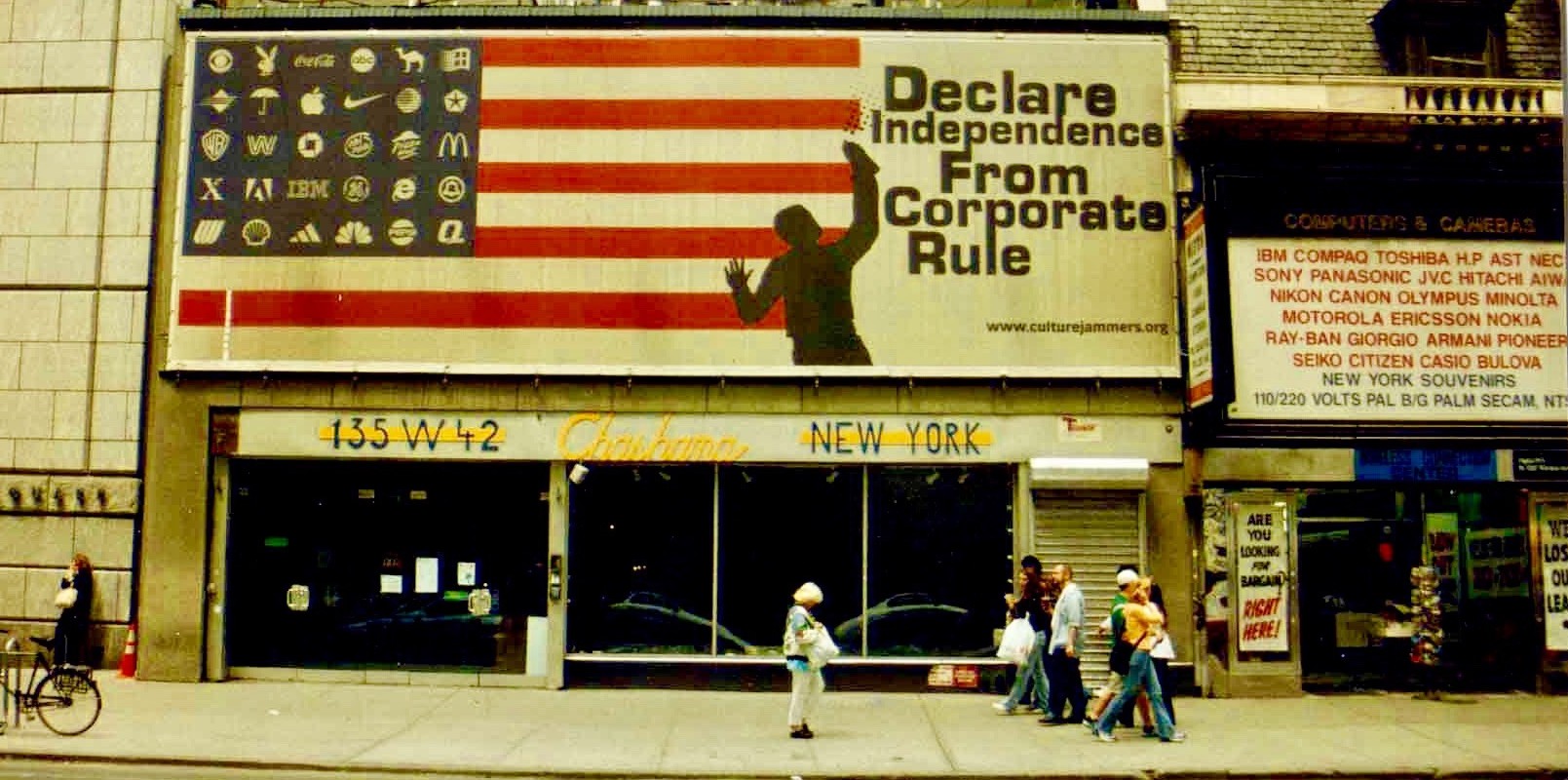On November 15, 2011, just outside a boarded-up vacant lot in Lower Manhattan, several NYPD officers held down a protester and beat him with batons while a number of onlookers, including the actor Frances McDormand, chanted “Shame, shame, shame.” (It was the first time I’d seen such an assault; I was working for Variety and on the lookout for quotable celebrities.) The protesters had gathered at the request of the Estonian-Canadian documentarian and activist Kalle Lasn, the charismatic founder and primary creative force behind the glossy magazine Adbusters. They had set up tents in Zuccotti Park and declared themselves Occupy Wall Street. This was not quite the second month of the occupation; it had begun on September 17, Lasn’s mother’s birthday.
Few publications are as synonymous with the early-2000s political left, such as it was, as Adbusters—the journal of catchy font design, broadsides by Slavoj Žižek, and that one picture of a ballerina atop the Wall Street Bull. In the public memory, it now takes some contemptuous knocks about directionless radicalism (you can still buy its upcycled Fluevogs), but it remains a part of our shared nostalgia for bookstores with magazine racks, as well as the birthplace of much of contemporary leftist American activism.

Screengrab from a video announcing issue number 149, via Adbusters’ YouTube page.
In 1989, Canadian television networks refused to sell Lasn thirty seconds of airtime for one of his “subvertisements,” this one featuring Claymation trees denouncing the lies of the logging industry. Lasn and Bill Schmalz, his friend and collaborator, sued, and founded Adbusters as a newsletter instead. The newsletter grew popular and became the magazine in 1992.
A given issue might include pithy contrarianism from Žižek, an excerpt—possibly defaced, possibly simply stolen—from a Starbucks training manual, and a collage of images from Soldier of Fortune magazine juxtaposed with screencaps from Activision’s Soldier of Fortune video game. Articles rarely moved with the tides: older pieces from the 1990s gleefully vandalized brands; the magazine spent the 2000s inveighing against the war in Iraq and mindless patriotism; Obama-era articles tended to pick on Big Tech. In a sea of lifestyle magazines, it was, to some extent, also a lifestyle magazine, suggesting ways to change your daily routine to protect yourself from the invasion of the brands.
“I’m nostalgic for it sometimes,” Stefanie Krasnow, who was the publication’s editor from 2012 until 2014, says. “It seemed to be a place perennially full of idealistic, radical people in their early twenties.” The magazine is still published, bimonthly, by the not-for-profit Adbusters Media Foundation; its website recently plugged a forthcoming issue alongside a critique of the coordinated GameStop investment campaign, which it termed “a deserving blow” to hedge funds delivered by investors who were nonetheless “playing into the very system that screwed them in the first place.” Krasnow says Adbusters is a “single-voiced” publication, with Lasn as its driving creative force.
Jonathan Barnbrook, a graphic designer who contributed to the magazine and art-directed it twice, first encountered it in the late 1990s, at the Tower Records flagship in Piccadilly Circus, London. “I couldn’t breathe, looking through it,” Barnbrook says. “It was exactly how I felt and how many people I knew felt at the time.” Back then, few issues felt as urgent to the perennially disenfranchised left as the rise of globalization; the end of the decade saw the J18 and Battle of Seattle protests over trade deals that exploited laborers in poor countries, and Barnbrook was disgusted with his profession’s complicity in the corresponding rise of lucrative advertising campaigns calibrated to drown out criticism.
“It was a certain point in design where multinationals had started using sweatshop labor and designers had been very complicit,” Barnbrook recalls. “They just went for it, because they liked working with companies like Nike and Adidas because they had this cool aura.” Adbusters, he says, offered a necessary corrective: “Here was something that fought advertising using its own tools. The line was very clear, and the copy was very well-written.” For Barnbrook, Adbusters carried a more important message than its anti-corporate stance: it told him he wasn’t alone.

Lauren Bercovitch, public relations and production manager of Adbusters, shows the magazine’s centerfold of a ballerina on the Wall Street bull. Image from 2011. Photo credit: Deborah Jones/AFP via Getty Images
During the final years of the print-media boom, Adbusters was a sort of anti–September Issue—a glossy magazine filled with fake ads for fashion designers and liquor companies, Banksy-style invective against industrial farming, and announcements of protest. “Kalle always says in Adbusters that advertising is brain damage,” Krasnow recalls. “What he did with Adbusters in terms of ‘jamming’ the magazine space was brilliant and radical aesthetically.”
The magazine was many things, but consistent was not one of them. “So many of Adbusters’ actual prescriptions—at least the ones they’re best remembered for—are lifestyle choices,” recalls Luke Savage, a staff writer for Jacobin who calls Adbusters one of his entry points to leftist politics as a teenager. “I remember one article about treating your media diet like mainstream media is junk food. And I remember another article that said you should connect with Mother Nature by making tea out of dandelions.”
Trevor Clarke, 26 and a writer-editor at the magazine, remembers first discovering it at “sustainability camp” during his freshman year of high school. “The camp counsellors had all of us students eat vegetarian food and coin woodland nicknames for ourselves,” Clarke remembers. “They also furnished us with various kinds of radical literature, including copies of Adbusters.”
In many ways, Adbusters is a 1990s time capsule, but part of the 1990s was nostalgia for the 1960s, and if back issues of the magazine look politically suspicious and filled with crackpotism today, at the time it looked like a gloomy, concretized Whole Earth Catalog. Occupy Wall Street, Savage says, was the magazine’s greatest contribution to the world. To Savage and others for whom Adbusters once marked the furthest reaches of radical thought, its legacy outstrips its own achievements.
During Occupy, even sympathetic journalists expressed frustration with what they came to regard as a disjointed coalition without clear demands. But from that group came the Fight for $15 minimum-wage walkouts, and other publications, too—filled not with slick anti-corporate un-branding, but calls to action on pulp—like The Occupied Wall Street Journal, which published writers including Arun Gupta (now of The Intercept) and reporter and commentator Michael Levitin. It was a moment that prefigured the leaderless protest movements to come, especially Black Lives Matter.
The Occupy protests were also a watershed in publicity around police misconduct: grainy video of riot-geared cops beating protesters, some of them homeless, informed a new generation of leftists’ understanding of capital’s resistance to change. That generation has rejected much of what Adbusters stood for, in part because of the urgency publications like Jacobin and Current Affairs have brought to the need for a fairer political system.
Krasnow, the former Adbusters editor, also cites Micah White, Lasn’s close colleague during Occupy and the publication’s longest-serving editor, as an inspirational figure—one who understood the use of the levers of power. White was instrumental in creating the buzz around the Occupy movement, which he has said he now considers “a constructive failure.” (White declined to be interviewed for this piece. “I don’t feel like doing the interview, so I’ll pass, but I wish Adbusters and Kalle all the best,” he said.) He is now a regular guest on MSNBC and recently wrote for The Guardian about attending the World Economic Forum in Davos “to discover its revolutionary potential”; other leftists have criticized him for seeking to rebrand himself as a consultant for activist groups after the end of Occupy, but it is hard to write him off as ineffective.
In many ways, the frustrating, inspiring hippiedom underneath Adbusters’ aesthetically daring exterior is simply Lasn himself. In conversation, Lasn, now seventy-nine, is the exact inverse of an angry radical. Determinedly avuncular, he can easily steer all topics of conversation, no matter how personal, toward the need for a sustainable future, the promise of an economy built around the “true cost” of producing goods that despoil the environment, and the need to escape capitalism. It’s a quality that would be annoying if he were less sunny about everything.
Was life hard as a two-year-old child refugee in Nazi Germany, where his parents had fled the Russian invasion of Estonia? “In Germany, it was a little tougher because, yes, it was still hard to get food right after the war,” he admits. “But when we were in the refugee camps in Australia [where his family relocated after they and many Estonians were displaced by World War II], you know, there was good food! We were living in corrugated-iron shacks, but still, you know, we had a nice bed!”
Did the global financial crisis of 2008 represent the triumph of capital? “It was a dark moment, but then, in our brainstorming sessions, we suddenly came up with this idea: Let’s do something really dramatic! Let’s go to the very iconic heart of global capitalism, which is Wall Street, and let’s occupy the damn place!”
Is he discouraged by the failure of Occupy to upend the global financial system? “We’re left with hundreds of thousands, perhaps millions, of people who got politicized during Occupy Wall Street—the same way that I was politicized, you know, fifty years earlier!”
Lasn is still waiting for the revolution, he says. He finds the Black Lives Matter and #MeToo movements “absolutely fascinating, but somehow they don’t get to the heart of the matter.” He says he celebrates intersectionality, but that “it doesn’t quite amount to what I dream of, which is a world revolution, and a moment when we the people, using the power of the internet, launch a global movement that changes the way governance works, that changes the way our leaders behave, and that changes the way that the democracy functions.”
Krasnow, who left journalism to work as a clinical counselor, says that while there are trenchant critiques of identity-driven intersectional leftism to be made, it’s wrong to consider the competing wing of the movement subordinate. “The Black Lives Matter, Indigenous-sovereignty, and anti-pipeline movements—I can’t say why they gained popularity, but they have an urgency to them, and a strength, because they are coming from a place of survival, and not from a place of ‘leftist critique,’ or intellectualism, or post-whatever aesthetic,” she says. “I resent those movements being seen as leftist. I know why they are categorized as leftist, but I feel they ought to be seen in a space that’s beyond the right-left divide.”
Clarke hopes for further intra-left cooperation. “If your concern is to identify and alleviate one form of abuse—let’s say corporate malfeasance—then you ought to be attentive to other abuses which may compound, or be comorbid with, the first,” he tells CJR. “You can’t honestly claim to have justice at heart unless you do so. If the goal is to foster more just, more respectful, and more decent relations among human beings, then one must try to take note of all means by which that goal might be either advanced or impeded.”
Corporate dehumanization is still, at least, an enemy, and both the Adbusters team and its critics agree that it can be frustrating to see capitalists recycle criticism. “I remember when BP changed their logo to a green flower and spent more on their identity than they did on actual environmental work,” says Barnbrook.
Savage agrees. “Every brand was getting a piece of it after George Floyd’s murder,” he says. “It was savory snacks for social justice. Call of Duty: Modern Warfare put out a statement of support for Black Lives Matter. Adbusters was right to critique that stuff, but what was missing was a programmatic response.” Un-branding, too, gets co-opted and reworked into branding; there’s no escape from capitalism. But that doesn’t invalidate the criticism, either from activists focused on social justice or from anti-globalization anarchists.
Barnbrook says it’s important not to be discouraged by seeing criticism deracinated by cynical brands. “I don’t think you necessarily have to reconcile it,” he says. “I think everybody’s okay being fragmented, in a way.”
ICYMI: How a racialized disinformation campaign ties itself to The 1619 Project
Sam Thielman is the former Tow editor at the Columbia Journalism Review, and a reporter and critic based in New York. He is the creator, with film critic Alissa Wilkinson, of Young Adult Movie Ministry, a podcast about Christianity and movies, and his writing has been featured in The Guardian, Talking Points Memo, and Variety, among others.


